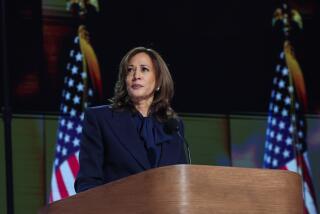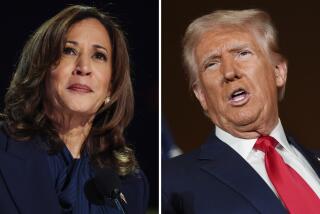Commercial Interruptions
- Share via
California’s broadcasters are bracing for a wild ride and a hefty windfall as millions of dollars in political advertising money are suddenly up for grabs at a time when demand for TV time is already strong.
Analysts estimate that more than $40 million will be spent on campaign commercials leading up to the Oct. 7 gubernatorial recall election.
Television stations will be happy to take the candidates’ money. “It’s gravy time for the media,” said veteran political consultant Hal Dash, president of Cerrell Associates of Los Angeles.
But there will be a downside. With so much political cash flooding the market, station executives will be forced to juggle the candidates who want to buy airtime with steadfast, year-round advertisers -- the stations’ bread and butter.
On Monday, Republican candidate Arnold Schwarzenegger became the first to pay for TV time, station executives said.
Schwarzenegger’s campaign bought an estimated $300,000 worth of time in the Los Angeles market for spots slated to begin airing this week.
Gov. Gray Davis, a Democrat, and other candidates, including Democrat Lt. Gov. Cruz Bustamante and Republican Bill Simon Jr., are expected to make buys in the coming days. Until they do, strategies -- and advertising budgets -- remain under wraps.
“Nobody has any clear idea of what’s going to be spent,” said Cathy Jacquemin, vice president for sales at KNBC-TV Channel 4 in Los Angeles. “But there’s already a lot of pressure in the marketplace.”
The campaign blitz comes at a busy time for TV stations. After a sluggish first half of the year, when advertisers trimmed spending because of uncertainty over the economy and the war in Iraq, stations are seeing an uptick in buys from retailers, automakers, car dealers and restaurants.
Now, the anticipated flurry of campaign ads is giving some traditional advertisers indigestion: Their commercials are among the most likely to be bumped to make room for political ads -- or to be overlooked as the election draws near.
Worse, they say, everyone will end up paying more as the supply diminishes and demand increases.
Year-round advertisers weeks ago ordered commercial spots to run during the launch of the new TV season, which officially begins Sept. 22. That’s just two weeks before the election, and political consultants are predicting that the two weeks leading up to the election will be a blizzard of campaign commercials.
“The bucket is already full, and so now it’s just going to overflow,” said Carolyn Bivens, president of Initiative North America, an ad-buying firm.
“There’s not going to be much inventory available, and anybody who waits until the last two weeks is going to have to pay dearly,” said Bivens, whose company’s client roster includes Coors Brewing Co. and Home Depot Inc. “Station executives are really going to have to juggle.”
As the political buying heats up, experts say it will draw attention to the little-known -- and some say unfair -- tiering system behind ad purchases.
The Federal Communications Commission requires stations to offer candidates advertising spots at the “lowest unit cost.”
FCC officials say the rules are intended to put candidates on equal footing with year-round advertisers, which have the advantage of buying in volume at a discount.
However, those cheaper commercials can be preempted by the highest-priced ads that stations guarantee will run during an agreed-upon time. Movie studios frequently buy at this rate to promote upcoming films.
As a result, politicians typically end up paying among the highest rates, so they can ensure their commercials will air in a time slot they requested -- not in the middle of the night or after the election.
Critics say the system means that only well-financed candidates can afford to play the game.
Last month, the Washington-based Alliance for Better Campaigns released a study that found that local TV stations around the country hiked prices for commercial time by an average of 53% during the final two months of the 2002 elections.
“Candidates who have a lot of money can just buy whatever they want,” said Dash, the political consultant.
Meanwhile, the increasing clout of cable channels and Spanish-language networks, including those owned by Univision Communications Inc., could help them land a greater share of the political dollars this year.
“As more viewers shift to cable, so should the dollars,” said Rick Oster, general sales manager for Adlink, which places commercials in Los Angeles on 44 cable networks.
“In a few weeks, it’s going to be a saturation-bombing campaign,” Dash said. “You’ll see the advertisements everywhere -- on Oxygen, Women’s Entertainment, ESPN and the National Geographic channel. Anyone who has time to sell will be selling it.”
More to Read
Get the L.A. Times Politics newsletter
Deeply reported insights into legislation, politics and policy from Sacramento, Washington and beyond. In your inbox twice per week.
You may occasionally receive promotional content from the Los Angeles Times.











